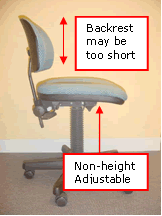Workstation ergonomics
Purpose
These guidelines are designed to ensure VFS employees are aware of the minimum standard for ergonomic office seating. These guidelines are specific to ergonomic chairs utilised as part of a workstation.
Office Seating
People sit at work to perform tasks that require concentration, posture, stability and visual access, often to be sustained up to 8 or 9 hours. Computer usage is an example of such work. For these situations, seating should be supportive and not require excessive work to maintain the seated posture. In general, seating for the workplace should:
- Be adjustable in height and back position.
- Be stable and safe to use
- Be in good repair
- Have appropriate lumbar and thigh support.
- Allow movement of the chair (via castors).
- Allow a variety of supported postures relevant for the nature of work being done.
Standards
The standard ergonomic chair should be within the following standard ranges and contain the following features: -
- Back Rest (Minimum 36cm Length)
- Seat Pan (Minimum 38cm Length) (AS/NZS 4438-1997/Amdt 1-1999)
- Adjustable Seat Height
- Adjustable Back Rest Height
- Adjustable Back Rest Angle
- Adequate Lumbar support.
Remember to consider the following to determine if your chair meets the VFS minimum standard:
- It should be adjustable to the task and be easily adjusted from the seated position.
- The seat should be height-adjustable, preferably utilising a gas lift for ease of adjustment.
- The seat should have a curved front edge, to minimise pressure on the underside of the thighs.
- The seat should be able to tilt slightly backwards or forwards.
- It should have a supportive backrest that is adjustable in height and angle
- Both the seat and backrest should be covered by cloth or some other type of material that breathes.
- It should have a five-star base for stability and have castor wheels that move freely on carpet.
- Armrests are optional; they help decrease the forces on the shoulders and back, but can limit access to the desk. It is generally recommended that they are not fitted to chairs where staff are involved in extended periods of computer use.
- If possible, choose a chair model that is available in a range of seat depths and backrest heights to accommodate all users needs.
Figure 1 is an example of a VFS standard ergonomic chair.

Figure 1
|
Non Standard Office Seating
Office seating used in meeting rooms and reception areas are not required to meet this standard. Examples of non-standard ergonomic office seating can be seen in figures 2, 3 and 4 below.

Figure 2 |

Figure 3 |

Figure 4 |
The standard ergonomic office chair used by VFS should accommodate 90-95% of the adult population. People outside this range may need seating tailored to their needs.
Further information/References
- Office wise - A guide to health and safety in the office http://www.workcover.vic.gov.au/




